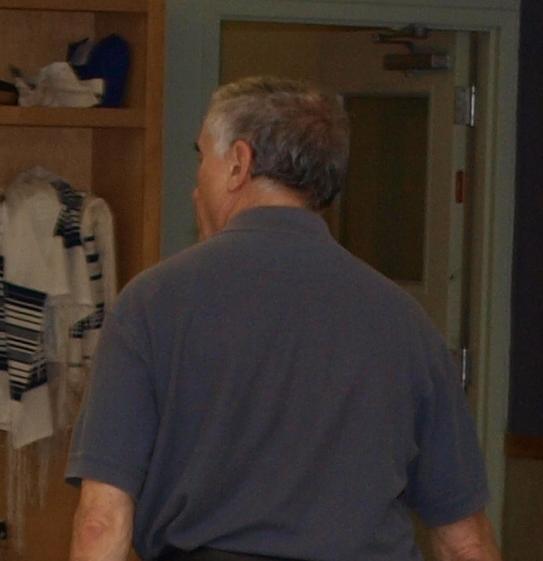

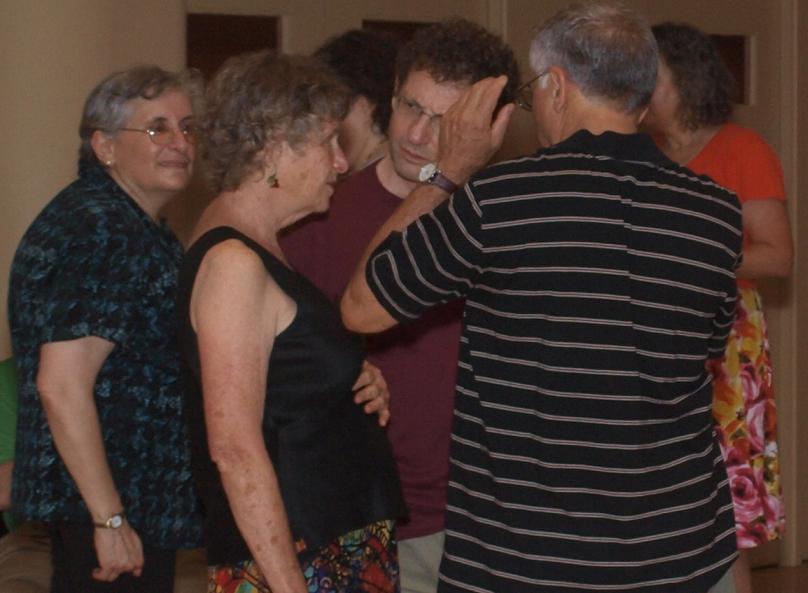

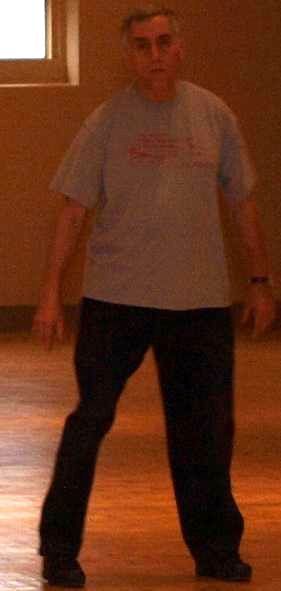





[Tdc Note: Some time ago we had asked Adam Baum to write up an easy Israeli dance and describe it for beginners with our help. This was the start of Adam's corner and the one and only script created highlighted Mayim Mayim and you can see that script by clicking here. Adam is not active in Israeli dance at the time of the preparation of this script, so we have asked John Frank, pictured above and below right, to take this over and describe Eretz Eretz for the beginning Israeli dancer. John is a well known psychiatrist in the Philadelphia area dealing with the psychiatric and psychological problems of minors and has become as equally well known for his Israeli dance expertise. We are pleased to be able to include this script in this web site although we have asterisked out some names to protect both the guilty and the innocent]
|
When **** ***** asked me to take over this section of his web site - a location to discuss and explain easy Israeli dances - I first tried to contact Rochelle to see if she and Adam would be returning to Israel dance and possibly this site. There has been some back and forth Email on this subject with her and it is possible that shortly we will see them back, but there are no specifics. In the interim, I have agreed to do this web page because I believe it is important for beginner Israeli dancers to have a location where their needs are met. A page describing introductory dances, what the lyrics mean, who the artists are and what are the steps would somewhat fill this need. It was decided that Eretz Eretz would be the dance that I would demonstrate. From a psychological view it is relevant to me. It is a dance that describes one of the most basic of needs of our species - territorial behavior, the need of animals to stake out an area and defend it. Obviously, since the diaspora, this extends to the Jewish people's need for a homeland. This strikes a chord in many ways including the fact that my father, the journalist, Gerold Frank, reported on this as a war correspondent stationed in Europe, Russia and the Middle East during Word War II. He saw the horrors of that war first hand and the resultant need of the survivors to find a homeland. This need was repeated during the perilous era of the late 60's and 70's that questioned Israel's right to exist. It was at that time that this song was conceived and the music and lyrics written. I would like to give you, the beginning Israeli dancer, a little more information about this song in particular. For that, we need to cite another web site, www.israelidances.com, also known as the Aussie database. I'm sure you would agree that in this web site, thediskcoordinator.com, **** has created a very comprehensive, interesting, funny, warm and helpful web site dealing with the local Philadelphia Israeli dance scene, but even he would admit that for information on music, dance and choreography, the Israelidances site is the location to learn information about a specific dance and any beginner in Israeli dance should frequently consult it. 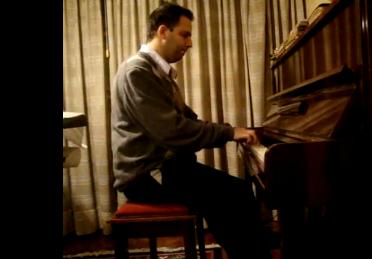 I ran the name, Eretz Eretz, through that database. I'm pretty sure that this song was composed in the early 70's. The composer and lyricist is Shaike Paikov. pictured at the left. The Israeli dance community is familiar with his work beyond this dance. If you attend the Germantown session, you have also danced to Eretz Israel Yafa, another of his compositions. At other local sessions, you might hear Tevorchi and Leorech Hashdera which again were composed by him. When listening to his other works, I recognize some partner dances that are done at the Thursday night and Sunday night sessions. I ran the name, Eretz Eretz, through that database. I'm pretty sure that this song was composed in the early 70's. The composer and lyricist is Shaike Paikov. pictured at the left. The Israeli dance community is familiar with his work beyond this dance. If you attend the Germantown session, you have also danced to Eretz Israel Yafa, another of his compositions. At other local sessions, you might hear Tevorchi and Leorech Hashdera which again were composed by him. When listening to his other works, I recognize some partner dances that are done at the Thursday night and Sunday night sessions.Below, through the Aussie database and Hebrewsongs.com we present the transliteration of the words on the left and the translation on the right. ****'s been nice enough to indicate in blue each stanza and highlight in blue the chorus. You can find the translations of many Israeli dance songs at both sites and we have copied this information about Eretz Eretz for you here.
|
|||||||||||||||||||||||||||||||||||||||||||||||||||||||||||||||||||||||||||||||||||||||||||||||||||||

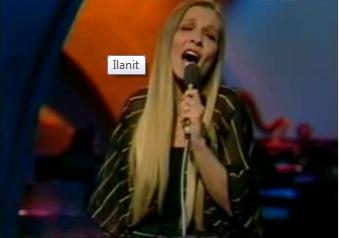
In the documentation on the Aussie database, the singer is indicated as Ilanit. The it at the end indicates a female name and it should be clear that our version of this song is sung by a male singer. In talking with ****, he tells me that he has been doing some research on Ilanit (TDC Note: Ilanit's real name as designated in Wikipedia is Hanna Drezner-Tzakhto, To the right and left are pictures of her at a younger age in concert) to be included someday on this web site. Per his information, Ilanit was a popular young singer in the early 70's when this song was created. She represented Israel several times in foreign competitions (especially in Europe) and was apparently very successful being named female singer of the year seven times. Like all successful singers, she had ongoing professional relationships with several composers and research seems to indicate that Paikov was one of them. Later in her career, she performed as a duet with a male singer and they were known as Ilan and Ilanit. Ilan, not his real name, eventually moved into music production and stopped singing, but one of the artists he represented was Ilanit. Several years ago, apparently at the turn of the century, Ilanit stopped perfroming and her last album was distributed in 1999. Recently, however, she has revived her career and we would be familiar with her present day singing as she is the voice we hear when dancing to Israelit which Jani Rosen helped introduce into this area several years ago. Of course, all of this is nice, but similar to much of ****'s research, it still doesn't answer the real question: who is the singer we hear on this version of Eretz Eretz? Ilanit may have been the first to sing this song, but this is not what we are hearing. But this story does go a long way of describing why this web site, thediskcoordinator.com, is so much fun to browse through as it tangentially whets your appetite with and for more information than you thought you wanted to know without answering the questions that are posed. Psychologically, it's kind of idiosyncracy with a flair.
Now, as far as the choreography, this is attributable to Yankele Levy and Shlomo Bachar. Somewhere on this web site is a discussion of Yankele Levy and it seems that he had helped shape the future of israeli dance in the late 1950s. The steps put in place on this dance are relatively easy, perfect for a beginner Israeli dancer. Even the sequencing is relatively non-sophisticated so that everyone, no matter what their skill, can participate in this dance.
There are two parts to the dance. Each "cycle' consists of the first part done twice and then the second part done twice. The duplication on the first part deals first with the first 4 lines of each stanza and then with the last 4 lines of each stanza. The first time of the second part deals with the first 4 lines of the chorus follwed by a repeat of the second part as the last 4 lines of the chorus are played. There are 3 'cycles' pertaining to the 3 times the music repeats itself. At the end, given a last phrase of music, the second part is repeated. If you are used to numbers, you could say this dance is 1,1,2,2,1,1,2,2,1,1,2,2,2,2. Notice the ending: the second part fully repeated so that it is done four times.
We'll write down the description of the steps first and then picturally reinforce this.
First Part
Overview - two semicircles and a set of leg kicks. The first part consists of two of what is described below
Second Part
Overview - movement right and left with ending kicks. The second part consists of two of what is described below
Above we have tried to describe this putting verbal commands to the page. Below, there are pictures of me doing this with a descriptions below each set of shots.
The sequence of shots above shows me as I'm doing the first part. At the start, I step on my right foot in a counterclockwise direction. Weight will be shifted to it, freeing my left leg. My left leg is moved behind me and I am in the process of pivoting on it. When the left is fully extended behind me, I shift weight on the left leg thereby stepping on it and now begin to move my right left to the side (further in a counterclockwise direction) and behind me completing a half circle. While moving my right leg backward, I am moving my left shoulder forward. In essence, I am creating an arc. I follow the momentum by shifting my weight and the result is that I have completed a 180 degree turn and now my back is against the circle as you can see by the fourth picture as I am now facing outward. We are about to do the same thing on;y mirrored as far as feet are concerned. I step on my left, shifing weight so that I can now move my right foot behind me. I extend my right leg as far it will go and put weight on it, freeing the left foot. The left foot continues in the counterclockwise direction to the side and back as I force my right shoulder forward as I again complete a 180 degree turn. I complete the turn by stepping on my right, shifting my weight so that I again have free the left leg. Not shown in the picture is a hesitation which in dance means a shift back and forth. I complete that here shifting on my right and then on my left so my right is free. All of this encompasses 8 beats of music. There are still eight beats to go in this first part and that sequence is explained below.
Having completed 2 semi circles and a hesitation, I am again facing the circle with my right foot free. Weight is on the left. I am about to do 8 steps never really moving from my position although my legs will kick out. I step on the right, step again on the left (and you guessed it, this is another hesitation) and with my weight on my left foot, kick my right foot out. We are about to do three steps in place - in essence a three step hesitation. The right goes back in place and weight put on it. Next shift your weight to the left and then back to your right. Two beats remain and these two beatsare filled by kicking out your left foot and then back in place freeing up your right. This is the first part of the dance and it utilizes 16 beats of music. My feet are placed so that I can either do part one again or preceed to part 2 which is described below.
Although the dancers I was next to as these pictures were taken did not reciprocate, usually hands are placed on the shoulders of those left and right of you. I am moving to the right with three quarters of a miyim (or three quarters of a grapevine if you understand that nomenclature). In the end, all this means is 3 steps of right left right. As to what you do with the left, some just place it in line with the right, and some put it in back similar to what is done above in the first part. Now, 3 steps back to where you were which again would be a left miyim or left grapevine as you are starting with your left foot. Nowm you muve your right foot back in place and put weight on it. Now it goes front without weight and just hangs in place. This is a form of what Israeli dancers call a cherkessia. Back to a standard position awaiting your repeat of this part, back possibly to the first part of the end of the song. If at the end, this process is repeated so the end result is that you do this 4 times.
Below are the videos of Eretz Eretz that I have been able to find on the internet (Youtube). This web site has incorporated these into its database and you should be able to link to each video and we have told you a little about who is performing this.
You can download this music as an MP3 file by clicking here.
**** ***** has a new video camera and decided on the spur of the moment to catch me by surprise(and several others) one Sunday at Germantown doing this dance. He has put this video, where we start really bad, but end up strong in doing this dance, on his web site. Before giving you the ability to access it, keep in mind that this is not streaming video - this is a gigantic download of 158 megs of an AVI video as he tells me. Only powerful machines using very high broadband communication links will be able to handle this at all and only the most powerful will handle it well. **** indicates that he is doing research into the question of streaming video, whatever that is, which would alleviate many of the problems of downloading. But, anyway, for a not really well done local version of this, you can click here.
As indicated above, this script supercedes the Adams Corner section of this web site. That script detailed Mayim Mayim. To see that script, click here